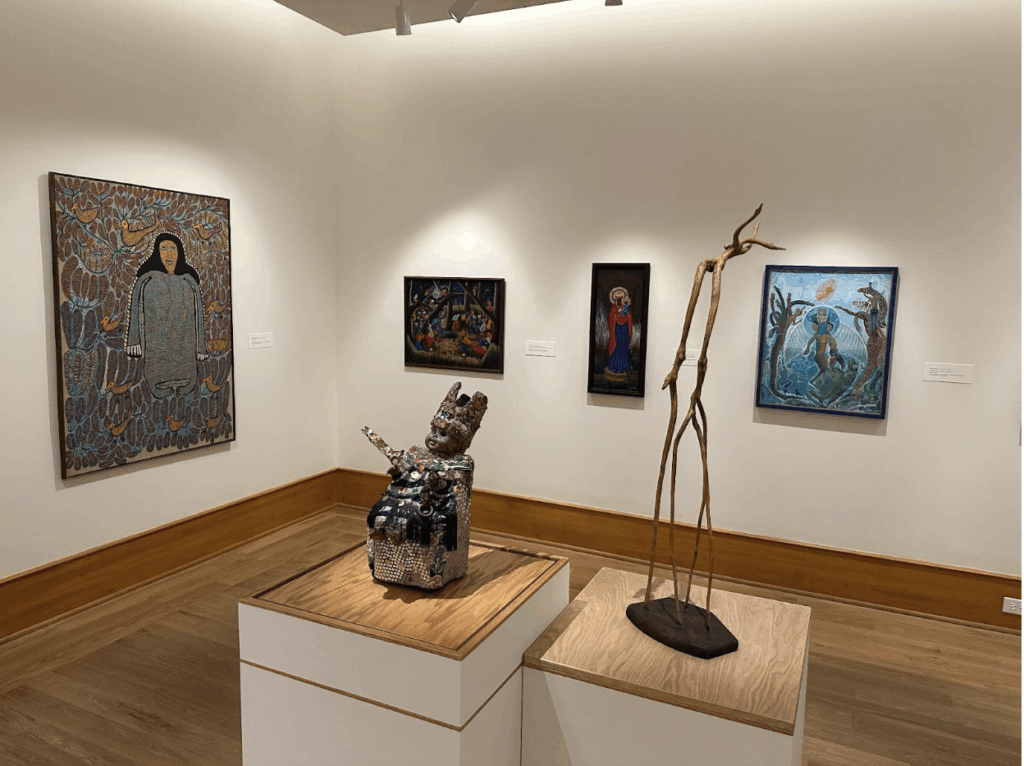Federal funding cuts to arts institutions hit home


The Des Moines Art Center and Waterloo Center for the Arts collaborated to bring a culturally significant exhibit featuring Haitian art to Central Iowa. Then, federal grant funding was pulled. The groups were able to color outside the lines and find a funding solution, illustrating how Iowa’s arts and culture organizations are managing federal policy changes.
Since the start of the year, the Department of Government Efficiency has slashed spending and fired thousands of workers. The federal government typically employs about 22,000 workers in Iowa or 1.4% of the workforce. It is unclear how many federal workers in Iowa have lost their jobs this year, but there have been firings at agencies like the National Centers for Animal Health in Ames and AmeriCorps.
Grant funding cuts were made as part of a DOGE initiative to reduce federal spending. In early April, arts and culture organizations across the country began receiving emails saying grant funds were cut for the current fiscal year, affecting thousands of projects and programs.
Statewide agencies like Humanities Iowa have had to tell the small arts organizations it serves that funding for current exhibits and projects is gone.
President Donald Trump’s 2026 Discretionary Budget recommendations issued on May 2 made the funding and agency cuts more formal, calling for the complete elimination of federal funding for several agencies, including National Endowment for the Humanities, National Endowment for the Arts, Institute of Museum and Library Services and more.
These changes have left arts groups scrambling for ways to fill funding gaps left by canceled grants that would have reimbursed them for money already spent. Some of the smaller groups are unsure of their future.
Coping with the cuts
One of the more than 1,200 NEH grants canceled in April was an $11,275 allotment to the Des Moines Art Center for its exhibit “Light Within Ourselves,” the result of the collaboration with the Waterloo Center for the Arts. The exhibit runs until Sept. 7.
“Light Within Ourselves” offers a sampling of what can be found at the Waterloo Center for the Arts, which has the largest collection of Haitian art in the United States. The Des Moines Art Center worked with the Waterloo center to bring 15 pieces of its 2,000-piece collection to the capital city.

Kelly Baum, John and Mary Pappajohn Director and CEO of the Des Moines Art Center, said she wanted to introduce the Waterloo collection to residents in Central Iowa.
“I’m reminded every day, and this fills me with a sense of purpose: This is the only art museum in the capital city of the state and one of the few art museums in the entire state,” Baum said. “We provide opportunities that no other institution in the city within a two-hour radius can provide. We might be the first and only place where residents of this region encounter art. We might be the only opportunity for residents of the area to travel imaginatively to different places, different countries.”
Funding loss leads to strong support
The grant to help pay for the exhibit and associated programming originated with the NEH and was to be distributed by the State Historical Society. When the grant was canceled, the Des Moines Art Center decided to continue with the exhibit, Baum said.
“We are going to carry on. We’re going to absorb the cost and make sure that the exhibition and the majority of the programs go on,” Baum said.
Baum said the Des Moines Art Center was able to maneuver the situation because of support from an endowment trust that covers about 55% of its budget, as well as strong support from donors and the business community.
“It’s really those smaller organizations and institutions that are going to be more profoundly affected by cuts to the NEH and IMLS,” she said. “We have an endowment and have the support of donors and corporate founders who helped make up the difference.”
Baum, who started her position in 2023, said one of the reasons why she accepted the Des Moines offer was because of the board of trustees’ commitment to the Art Center.
“I could tell from our discussions that they have the best interests of the Art Center at heart, but also fundamentally, the best interests of the city. They do what they do for the Art Center because they love Des Moines and because they want the best for Des Moines. They know that any great city really needs and deserves a great art museum, and so they are all working hard to protect the Art Center and also to protect the city and those institutions,” Baum said.
Baum and other Art Center leaders are looking ahead to sources of future funding for projects and exhibits. They had planned on applying to the IMLS for historical preservation funding.
“In the works were plans to apply for a grant to help us preserve our institutional archives, which are also the archives of the city of Des Moines and its people, its citizens, its residents,” she said. “Those are the kinds of projects that are challenging to fundraise. There are not many options for archival preservation, historic preservation, accessibility. We were thrilled to know that the IMLS was going to be there for us. The cuts to the IMLS will definitely have an impact, and we will pivot.”
Baum said there are ways the business community can support arts and cultural organizations during this time.
“I think that now is the time to have a conversation with elected officials,” she said. “It’s really up to every individual person, and this includes leaders in the business community, to decide what they believe and what’s right for them, what their values are and what kind of city, what kind of state they want to live in. And they might have access to individuals and offices that leaders of cultural organizations don’t.”
Business leaders can also help the community connect the dots between arts and cultural organizations and the impact they have on Central Iowa.
“It’s really helping others see what’s happening in D.C., and cuts to federal agencies are going to have a kickback effect on the state,” Baum said.
Smaller institutions affected
Smaller arts organizations work with limited budgets and losing grant reimbursement could hinder their ability to operate.
“The culture of Iowa is so rich and diverse and beautiful, but it was already kind of hanging on by a thread,” Baum said. “The budgets that they’re working with are so small, and some of the organizations might be supported by a staff of one or two, or a staff of one and a few volunteers. There wasn’t much meat on the bone to begin with in terms of staff, operational support. … For smaller organizations, grants from these larger federal agencies make up a larger percentage of their budget. They do really beautiful and important work, and it’s cultural activity that is rooted in the local [community] and it matters so much to those communities.”
Iowa’s designated humanities council Humanities Iowa, based in Ames, works with museums, art centers, nonprofits, communities and artists to help make projects and initiatives a reality. On April 2, Humanities Iowa was notified its funding had been terminated, effective immediately. All Humanities Iowa programs and grants are on pause.
The organization’s programming reaches 250,000 Iowans annually, in every part of the state, Heather Plucar, executive director of Humanities Iowa, said in an email. Examples of Humanities Iowa programming includes family and literacy programs, veterans programs, funding for rural libraries, museums and historical societies, book festivals and more.
The federal funding cuts ended existing grants and congressionally appropriated funds for fiscal year 2025, affecting programs that were already in motion. Some of those programs were already paid for by small libraries and museums that were counting on reimbursement from grant funding. A total dollar amount for Humanities Iowa’s 2025 revoked grant funding is so far unclear. The group granted $71,650 in grant funding in 2023.
Plucar said to help Humanities Iowa, the community can “visit [the website Save the NEH and send a clear message to state and federal legislators. Humanities councils are the most direct and concrete way for federal dollars to reach local constituents and institutions.”
Baum said federal funding cuts could affect thousands of jobs in Iowa. As of 2022, more than 20,795 Iowans work in the arts, entertainment and recreation sector, according to the Iowa Economic Development and Iowa Finance Authority.
“Arts and culture in Iowa employ thousands of people. We generate millions of dollars of economic gain. We spend money in the state,” Baum said. “Arts and culture is also a magnet for people who are moving to the state. We are important. We’re part of a larger statewide ecosystem, and we deserve to be protected and represented and advocated for, just like health, well-being, agriculture and more.”

Light Within Ourselves

When Chawne Paige, executive director of the Waterloo Center for the Arts, selected the 15 pieces on display at the Des Moines Art Center for the “Light Within Ourselves” exhibition, he considered several factors.
The Waterloo center’s Haitian art collection began in 1977 with a gift from Dr. Harold Reuling and his wife, Peg. Reuling was an ear, nose and throat doctor and traveled frequently with Peg to Haiti. The couple often returned to Waterloo with several pieces of local Haitian artwork. They later donated those pieces to the Waterloo Center of the Arts.
“Our collection started from a couple that traveled to Haiti, fell in love with Haiti and for the most part, Haiti was kind of a destination spot for them,” Paige said. “They fell in love with the artists that they met with, the landscape, with the beauty of what’s going on there and wanted to bring that back to Waterloo.”
Today, 88% of Iowa’s population is white and 4.3% is Black. During the 1960s, when the Reulings were traveling to Haiti, 8% of Waterloo’s population was Black. At that time, there were many strikes at the city’s factories by Black workers, demanding fair treatment.
“During the 1960s, there were ridiculous amounts of desegregation and racial unrest, rioting. We had a meatpacking plant in town. In the middle of that, there’s a bunch of strikes that were going on. There were strikebreakers that were brought to the community. It became this kind of powder keg,” Paige said. “Waterloo Center for the Arts sat in the crux of that, to partner with Waterloo community schools to help deal with integration, help deal with community conversations and in a way, bridging the community.”
Federal funding helped pay for a program called Cultural Explorations, which fostered community conversations.
“That program did a lot of the heavy lifting of how to meld and connect and create space for communities to grow and thrive and learn about each other,” he said.
The Reulings brought some of the Haitian artwork to the program.
“[The Reulings] knew that was happening, and thought that would be a great opportunity to also share Haiti within that conversation,” Paige said. “It’s not lost on on me, looking back at that time, [that here was] an opportunity for a white doctor and his wife to grab work from an African diasporic community, or Haiti or the products of the Transatlantic Slave Trade to bring work into a community that has Black representation.”
After curating Haitian art for the past 20 years, Paige will be the first to say he is not an expert in it.
“As a Black man in America myself, I can’t say that my education [of slavery], being a descendant of enslaved people here in the U.S., was a very well-rounded education of understanding,” he said. “It was a chapter, or a class presentation throughout my formative years.”
During the 1960s and 1970s, the all-white staff at the Waterloo art center did not have much knowledge around slave trade or Haitian art, he said.
“We didn’t necessarily know enough about Haiti, let alone the symbolism or how to interpret the work and present the work,” Paige said.
The center received federal grant funding to bolster the staff’s knowledge of Haitian art to better share the collection with the community.
The Waterloo collection has grown more sophisticated over the years. Many pieces have been part of traveling exhibits to other galleries and museums, from Des Moines to Miami.
“This collection definitely has grown to be a gem and something that our community is very proud of, but it’s also something that we’ve grown to want to share,” he said. “We definitely want people to come to Waterloo and see the collection.”
The Waterloo center has also collaborated with scholars at Grinnell College on the Haitian Art Digital Crossroads, an online database of Haitian artwork and its meanings and symbolism. Funded by an NEH grant, the Haitian Art Digital Crossroads database is free and open to scholars globally.
“[The goal is] to learn more about Haitian art and to go far beyond just the provenance of an artwork, like, what’s the name, what’s the title, who’s the artist? The attempt is to actually go further than that, to get into a lot of the symbolism, to create an actual Haitian Creole thesaurus that has the ability to give people words and terminology of different things that are happening within the work,” Paige said. “Some of those [interpretations] are based on European paradigms and not necessarily on African traditions or let alone Haitian Creole traditions.”
Paige said the exhibit at the Waterloo center is more immersive than the 15 pieces seen at the Des Moines Art Center, which he selected to spotlight different media and master artists.
“They were tightly selected to be able to work independently as objects in themselves and represent those individual artists who represent individual mediums,” Paige said. “I think the No. 1 thing was to try to celebrate all of the different styles and voices and aesthetics that one could experience in Haiti.”
Through some pieces in the Des Moines exhibit, the connection between influential master artists and their apprentices is apparent. An example is Haitian flagmaker Myrlande Constant, who is considered a master artist, and artist Roudy Azor.
“My hope is with the exhibit there is a step forward as a community and across Iowa to embrace the makeup of our whole community and these voices,” Paige said. “We now finally have Haitians within our community [in Waterloo], and it’s really now providing a space for our Haitian community to have agency with their own works and their own narratives.”

Gigi Wood
Gigi Wood is a senior staff writer at Business Record. She covers economic development, government policy and law, agriculture, energy, and manufacturing.









